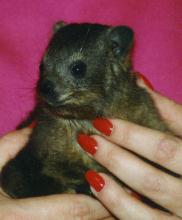Rock
Hyrax (Dassies)
Here is a 6 week-old baby rock hyrax.
Hyraxes are also called Rock Dassies inhabit a large portion Egypt, Syria, Lebanon,
Israel, Jordan, Sinai, Libya and other parts of Africa. They enjoy living in rock
covered habitat of scrubby plants and bushes.
Order: Hyracoidea
Family: Procaviidae
Genus: Procavia
Species: Capensis
Dentition for the permanent teeth is i1/2, c0/0, pm4/4, m3/3 x 2 for a total of
34. The upper incisors are triangular in cross section similar to a tusk and grow
continuously. They are 11 to 24 inches long. They can weigh up to 10 lb. They
have a fine undercoat and long coarse guard hairs. They have a gland on the back,
marked with a dark patch. They have an unusual structure to the iris of the eye
where the upper part protrudes forward a bit and cuts out light from above. They
have a short snout and the upper lip is cleft. Their legs are short and strong
with four digits on the front foot and three on the rear foot. They have a sharp
claw on the inner toe on the rear foot and all the rest of the toes have hoof-like
nails. They have a musculature in the sole of the foot that can retract the middle
of the sole so that the foot acts like a suction cup when climbing. The males
do not have a scrotum. They have good senses of sight and hearing.
Hyrax have a coat as soft as a chinchilla's
coat.
Mating is seasonal for about 2-3 months varying with the local. The estrus cycle
lasts about 13 days and gestation is 202-245 days. Litters are from 1 to 6 but
average 3. Babies are born fully furred, with eyes and ears open and move about
with the mother the second day. They begin to eat food at 2 weeks and continue
to nurse from 2 to 5 months. They have been know to live about 11 years.
They live in crevices and burrows. They are agile climbers. They are poor regulators
of heat so are not foraging when it is very hot or too cold. They are mostly active
in the daytime unless it is very hot. They live in large colonies of over 50 animals.
They live in large groups and as many as 25 will share a single den.
Hyrax live in rock crevices.
The rocks absorb heat from the sun to keep them warm during the night and the
crevices keep them cool during the hottest part of the day.
In captivity
Enclosures for captive animals should be have no more than 2" x 4" openings, should
prevent escape by climbing, by using a cover. They are avid climbers and diggers
so they should have clay floors covered by wire mesh and 6" - 12" of clean sand.
These animals are very clean and will use the same portion of their enclosure
for their toilet activities. They can jump 4-5 feet high! They need a sleeping
place so provide a nest box or a pile of rocks where they can find a crevice to
sleep in. Add some grass hay or leaves for nesting materials. If you have a concrete
floor, they will readily use a sand box for a potty area as these animals are
very neat. Handle them with heavy gloves to avoid bites.
Their diet in the wild consists of grass, branches, shrubs and other plants. It
is able to secure much of its needed moisture from the plants it eats, but will
drink if water is available. They can impact with sand so be sure the moist food
does not fall on the ground and then be consumed. Put their food container on
a sheet of plywood of fiberglass sheet.
Fruits and vegetables such as carrots, orange, apple, lettuce, banana, sweet potato.
Add monkey chow, hay, rabbit pellets, and bread.
In addition to the normal diet, provide something non-toxic to chew on such as
willow or birch branches. Check with your county extension agent or poison control
center if you wish to feed branches from trees you do not know are absolutely
safe. You may wish to consider Purina MazuriO Browser diet, Lagomorph and rodent
diets with the fruits and vegetables.
Infants can be hand-reared using KMRO or EsbilacO with added vitamins or EsbilacO,
KMRO and water (1:1:3) They should be kept at 75 degrees F. Feed every four hours
until 3 weeks old, day and night. The next two weeks increase feedings, and decrease
number of times per day, eliminating night feedings. From 2 weeks of age, offer
solids including hay, romaine lettuce, grains and fruits. When eating well, at
about 6 weeks, eliminate milk. The young, after the long gestation, are born ready
to eat solid food within a day of birth.
R-Zu-2-U Home
R-Zu-2-U FAQs
R-Zu-2-U Animal "Terms"
Treasure Ranch Home



